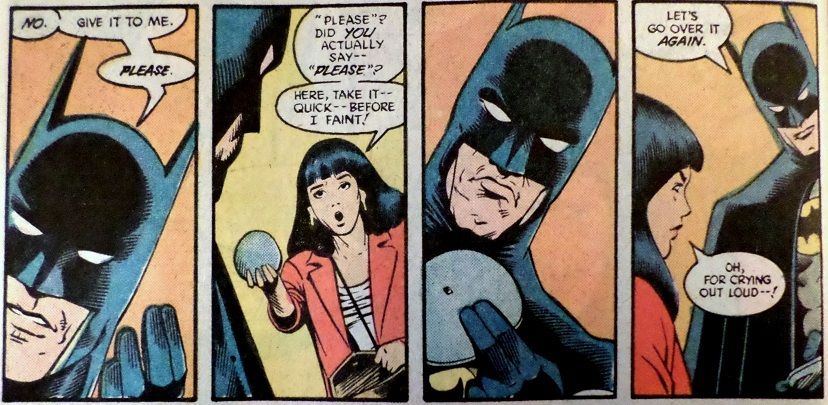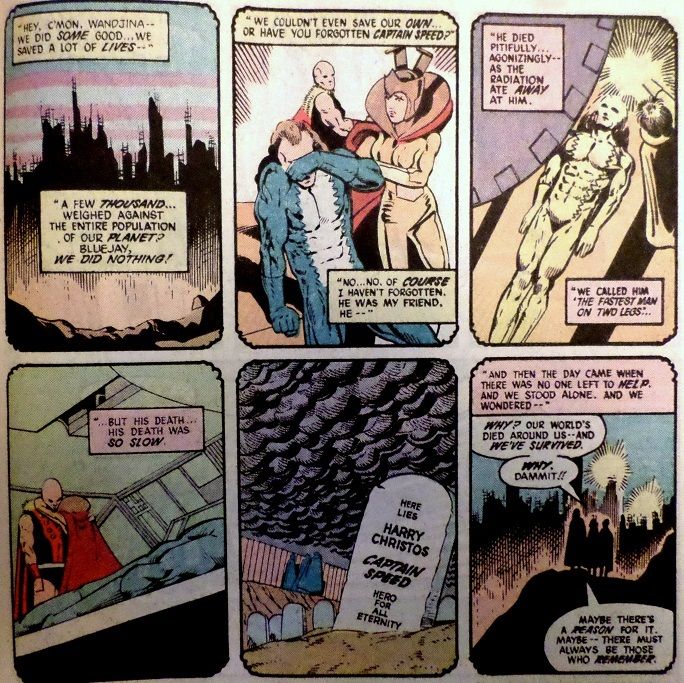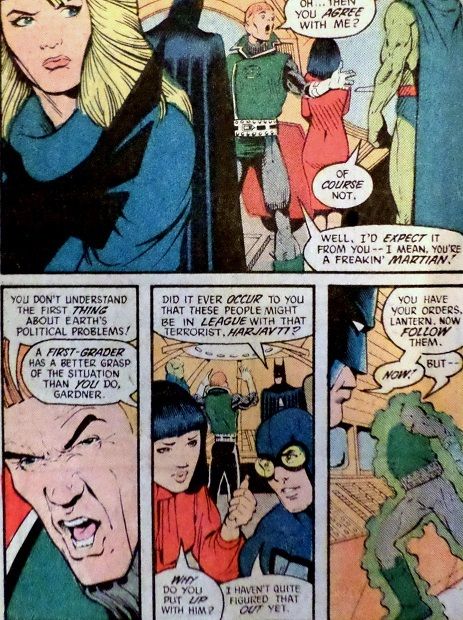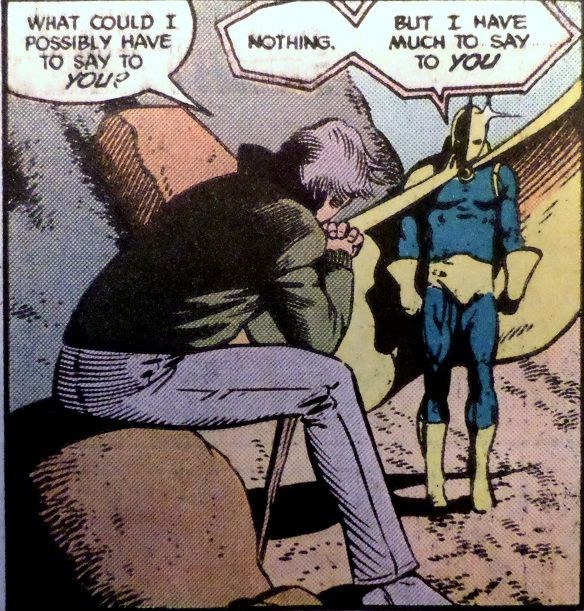Justice League #2

"Make War No More!"
plot and breakdowns: Keith Giffen
script: J.M. DeMatteis
pencils: Kevin Maguire
inks: Al Gordon
letters: Bob Lappan
colors: Gene D'Angelo
editor: Andrew Helfer
grade: A-
Man, if I was at all on the fence about this new Justice League, that uninspiring cover likely would have turned me away from following them into this second outing. Good thing it's the only subpar aspect of this second issue.
Whereas Giffen found immense success with the clubhouse environment of the first issue, depicting what an amateur group of superheroes might be like together when the cameras aren't rolling (think MTV's The Real World for superheroes), this issue resists the urge to stay complacent and stick with what's already working. Sure, Giffen's humor and pacing are still top-notch, Maguire's still capturing that pre-reality TV feeling with his life-like movements and facial expressions, and Al Gordon as the new inker on this issue does that penciling more justice than ever before

but there's so much more at work within this issue, sending a clear message that Giffen had more in mind for this series than a bunch of cheap laughs.
Last issue, the team faced off against a bunch of terrorists who, their mentally unstable leader aside, had stemmed out of admirable social justice groups fighting to make the world a better place and desperate after decades of not seeing any progress. So, while they were clearly in the wrong in holding the United Nations hostage, there was at least something unsettling about the idea that their motives were admirable.
This issue further plays upon such confusion, introducing villains who -- once you get to know them --
aren't villains. What initially seemed like a brand new flavor-of-the-month team of super powered baddies ends up being The Assemblers, an alien super-team akin to the Justice League from way back in the early 1970s, and their back story and motives are tremendously touching:

A super team that failed to stop the nuclear annihilation of their own planet, now sworn to prevent such tragedy from occurring on other worlds. Heck, isn't that just a magnified version of Batman's solemn oath?
But the point is that we can understand it, and we're not entirely sure they are wrong, even if what they are doing -- forcibly destroying the nuclear arsenals of the Earth without anyone's permission -- is against the law.
And that makes things interesting when we explore the new Justice League's perspective on The Assemblers' mission:

Guy is reeling off simple jengoistic propaganda in favor of trashing everyone's nukes except for the United States' because "Nobody but Ronnie-Boy should have his fingers on the button! THEN we'd have the world where we want it, huh?" But the more disturbing part is that no one on the team has an informed response to the issue of nuclear disarmament in contrast. They dismiss Guy's perspective out of hand and
know The Assemblers are wrong, but beyond the fear that these "villains" might be doing the bidding of a terrorist, they don't really know
why they're wrong.
And therein lies the power of this issue -- we're rooting for the villains. They have thought this out. They are committed to their goal. In contrast, the Justice League is just an unorganized group of complacent and entitled folks who have never really asked the hard questions of themselves. In essence, it's not just Giffen's humor that feels real, nor Maguire's pencils -- This new Justice League
is America; uninformed, un-united, and far better at making asses of themselves than saving the day.
And Keith Giffen's got something to say about that. After all, the major villains in these first two issues aren't super powered bad guys; they're smooth-talking spin doctors who twist the truth to serve their own ends. There is, of course, Maxwell Lord, manipulating things in the background since last issue, and now this fascist dictator guy who is desperately trying to manipulate the Assemblers, though they are too smart and informed to buy it.

So there is a method to the madness that is the new Justice League. When Giffen is making us laugh, he's really trying to make us laugh at ourselves and, in the process, start asking ourselves how we as both individuals and a nation can start becoming informed and proactive leaders in the world who are not so easily manipulated anymore.
I did
not see that one coming.
Minor Details:- The Assemblers are a nice nod to old old Pre-Crisis Justice League continuity, a goodwill gesture to fans who might be seeing the new team as a disruptive insult to the legacy. It's also yet another reminder that the Post-Crisis "reboot" for the Justice League is a darn messy one.
- Giffen and DeMatteis work a few subtle criticisms of simplistic political ideas into this issue, and I wonder if The Assemblers' mission isn't a gentle critique of the upcoming DC film, Superman IV: The Quest for Peace, in which Superman attempts to do exactly what The Assemblers are doing here.
- Where is Oberon in this issue??
- Presumably, Maxwell Lord is speaking to
Booster Gold here about joining the team.

Though the usage of names here hardly seems accidental. The big CEO who knows and controls everything is literally named MAX(imum) LORD, even calling up files on Jack Ryder when he doesn't like the press he's giving to the Justice League (and yes, he knows who Ryder
really is). So, when he calls in "Mr. Gold," I half wonder if Giffen and DeMatteis are hoping we'll assume he's calling in DC editor Mike Gold; that he just has that much power.
- My bad. Last issue, I presumed the Justice League HQ our new team was meeting at was the home of the previous team in Detroit. Apparently, it's not.

So is this a new HQ (if so, who built it, and who told them about it?) or an older one?
- Characterizations remain consistent from last issue, especially with Batman being surprisingly darker than he was over at the Bat Office

and with neither Mister Miracle nor Black Canary receiving any real characterization. A year from now, Secret Origins #32 will rewrite the history of the JLA, making Black Canary a founding member, yet she hangs out in the background here, having no presence except when fighting with Guy.
- Continuing to distance himself in this issue, Dr. Fate does not interact with the team at all in these pages. Instead, we simply see him interact with someone who is ready to give up on his mission, which Dr. Fate warns is a dangerous idea.

I get the sense that this is a Lord of Order, and we're getting foreshadowing about the defeat of Order and the coming Fourth Age of Man.
Great characterization and humor continues, but so much more is at work in this issue. I'm just now beginning to understand how much one of my other favorite superhero teams of all time, Warren Ellis' The Authority, used this run as its basis.